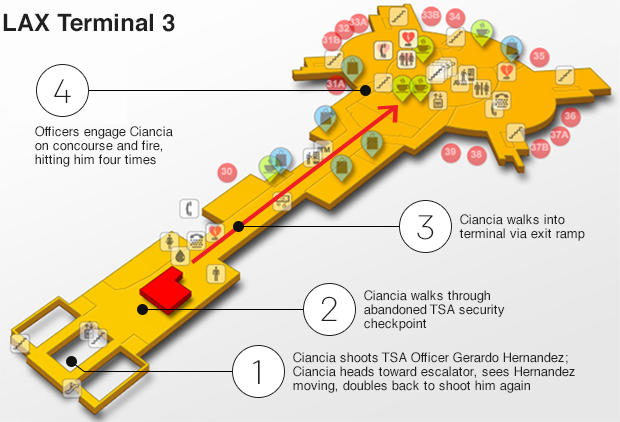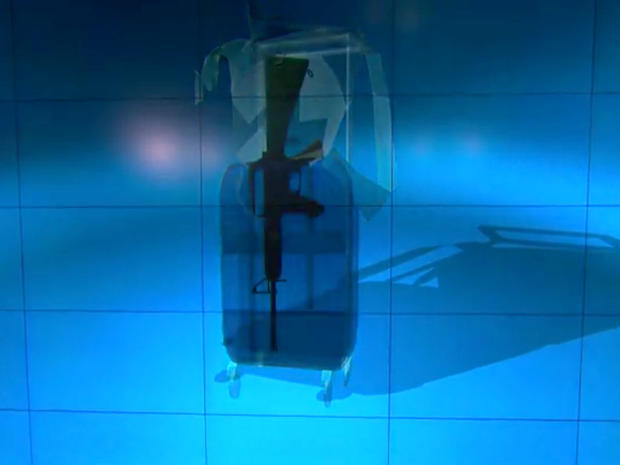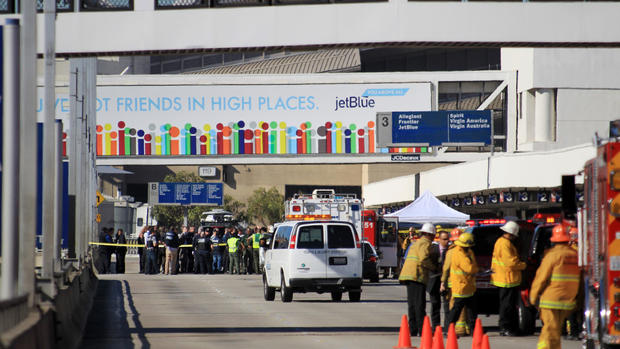The LAX shootings, as they happened
(CBS) LAX shooting suspect in Friday's rampage, Paul Ciancia, arrived at the airport driven by a friend in a Black Hyundai. Ciancia walked into the departure level of terminal 3, looking like any other passenger, pulling a "roller board" suitcase with a backpack riding on top of it. The rolling suitcase and the backpack had been carefully modified. A hole in the top of the suitcase and the bottom of the backpack so that the assault weapon could stand up inside the two bags.
Law enforcement sources say Ciancia then pulled the backpack off the top, lifted the .223-caliber assault rifle up through the hole in the suitcase and shot TSA Officer Gerardo Hernandez.
Hernandez, a TSA Behavioral Detection Officer, was specially trained to observe suspicious behavioral traits among passengers. He was assigned to check documents and boarding passes at the bottom of the escalator that leads up to the TSA checkpoint.
A law enforcement source told CBS News that after shooting Hernandez, Ciancia headed toward the escalator, but saw Hernandez was still moving, so he doubled back and shot him again, killing him.
The new details of the attack emerged from law enforcement sources who have seen or been briefed on statements made by witnesses and the review of images from dozens of airport security cameras that captured various parts of the shootings.
After the first shots, on the ticket counter level, panicked passengers scattered while just upstairs, at the top of the escalator, Ciancia arrived at the TSA checkpoint to find that the TSA officers and passengers had all fled, after hearing the shots fired on the lower level. A lone female passenger stood frozen as Ciancia walked by, ignoring her.
By then, a call had gone out over the Airport Police radio frequency: "SHOTS FIRED, SHOTS FIRED, SHOTS FIRED, TERMINAL THREE." Every available officer began to converge on the scene.
On the upper level, Ciancia walked around the outside of the checkpoint, entering the sterile area behind security by walking down the exit lane reserved for deplaning passengers. He headed down the concourse and, according to law enforcement sources, appeared to be "hunting" TSA Officers.
Investigators told CBS News that some of the passengers wounded may have been hit by rounds Ciancia fired while aiming at TSA officers, easily spotted at a distance in their bright blue uniform shirts.
Los Angeles World Airport Authority (LAWA) police officers arrived on the scene within seconds of the radio call and formed a four officer "contact team" to go after the suspect.
A law enforcement source said within about a minute from the time the call went out, the officers had engaged Ciancia on the concourse and fired, hitting him four times.
As they handcuffed the wounded gunman, the officers asked if he was alone, or if there were others with him. According to law enforcement sources, Ciancia told the officers he acted alone.
When asked where his car was, he told the officers he had been dropped off by a friend. On Saturday, the FBI questioned the friend, reportedly one of Ciancia's roommates, who admitted dropping Ciancia at the airport, but denied any knowledge of his plan, or that he had a weapon concealed in his two bags. The FBI investigation into the man's account is continuing.
Just three and a half weeks earlier, the officers involved in the shooting and capture of Ciancia had been part of a massive "active shooter" training exercise at an empty terminal at the LAWA airport in Ontario, California. The scenario involved multiple gunman who shot their way past a TSA Screening Checkpoint and ran down the terminal intending to hijack an aircraft loaded with passengers. The goal of the drill was to get officers to quickly form small "contact teams" and go after the gunmen. The training is a sea change in decades of law enforcement protocols that called for containing the gunmen within a perimeter while waiting for SWAT teams to arrive. The new procedures, born out of a rash of shootings in public places by emotionally disturbed people with assault weapons takes into account the "hunting behavior" of these shooters, who will continue to seek out victims rather than attempt to hide or flee.
Since Friday's shooting, questions have been raised by the union representing the airport police about a change in procedures taken by the LAWA Police Department several months ago.
Since 9/11, the Los Angeles airports have had an officer stationed behind every TSA screening checkpoint in the airport. When Chief Patrick Gannon took over the airport police a year ago, he revised how police patrol at LAX. Gannon's thinking, according to people who were briefed on it, was that the security posture at LAX had become too stagnant and predictable.
The police, working from "fixed posts" just beyond the security checkpoints, stood at podiums or sat in kiosks. Gannon felt it made the locations of the officers predictable to anyone planning an attack, and limited the amount of ground they could cover. A study of attacks at LAX and other airports supported the idea that the major threats have occurred in front of the security checkpoints, rather than beyond them.
In 2000, an al Qaeda plot to blow up a terminal at LAX was uncovered with the arrest at the Canadian border of Ahmed Ressam. Ressam would later tell the FBI that he'd planned to leave bombs hidden in suitcases inside an LAX terminal by the ticket counter on New Year's Day. When Hesham Mohamed Hadayet, a 41-year-old Egyptian limo driver opened fire at the El Al ticket counter on July 4, 2002, it was also in the entrance of the Tom Bradley International T Terminal, before the security checkpoints. Based in part on that history, the LAX police brass wanted the officers to have more flexibility to move through the terminals to increase visibility and increase the likelihood that they would be nearby if an incident began to unfold.
While Friday's incident -- where a gunman targeted TSA employees at a checkpoint will raise questions as to whether police would return to their "fixed posts" at the checkpoints -- one law enforcement official pointed out that the shooting of the first TSA Officer took place on the main floor of the terminal, opposite the ticket counters, and before he proceeded upstairs to the checkpoint.
"The fact that from the time the call went out, until the officers encountered the suspect was just about a minute, argues that the system worked", said one law enforcement official involved in the investigation. "But you're going to get second-guessed after one of these things no matter what you do. It comes with the territory."



